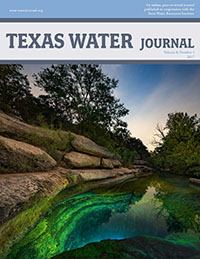Abstract
The Barton Springs segment of the Edwards Aquifer represents a small, relatively independent part of the aquifer. Data for the sources of recharge and especially for discharge from the aquifer are well documented. Based on a 6-year water budget of surface recharge and surface discharge, the volumes match within 5%, which is within the potential error limits of the recharge and discharge values. Recharge volumes include increased runoff due to urbanization in the recharge area. A previous water budget based on an earlier period also displayed a balance between recharge and discharge volumes. Both budgets are based on slightly “wetter” than long-term mean recharge and discharge conditions, thus subsurface recharge from south of the aquifer segment, which is documented to occur during dry conditions, was an insignificant source of recharge during the budget periods.
The recharge volumes are based on data from streamflow gaging stations operated by the U.S. Geological Survey. However, one of the stations (Bear Creek near Brodie Lane) was discontinued in 2010; this station is needed to calculate recharge volumes on Bear Creek and Little Bear Creek. Because of the discontinuance of the station, any calculations of recharge volumes after 2010 would contain substantial potential error.
Citation: Slade RM, 2017. A recharge-discharge water budget and evaluation of water budgets for the Edwards Aquifer associated with Barton Springs. Texas Water Journal. 8(1):42-56. Available from: https://doi.org/10.21423/twj.v8i1.7020.
References
Austin, City Of. 2009. Stormwater runoff quality and quantity from small watersheds in Austin, TX: Updated through 2008. Austin (Texas: City of Austin. Report number: CM-09-03. http://www.austintexas.gov/watershed_protec¬tion/publications/document.cfm?id=196394
Brune G. 1975. Major and historical springs of Texas. Austin (Texas): Texas Water Development Board. Report 189. 94 p.
Brune G, Duffin GL. 1983. Occurrence, availability, and quality of groundwater in Travis County, Texas. Austin (Texas): Texas Department of Water Resources. Report 276, 219 p.
Casteel R, Hunt B, Smith B. 2013. Evaluating the hydro¬logic connection of the Blanco River and Barton Springs using discharge and geochemical data: BSEACD Report of Investigations 2013-0701. http://bseacd.org/uploads/ Blanco_Barton-Report_FINAL.pdf
Dugas WA, Hicks RA, Wright P. 1998. Effect of removal of Juniperus ashei on evapotranspiration and runoff in the Seco Creek Watershed. Water Resource Research. 34(6):1499-1506. doi:10.1029/98WR00556
Garza S. 1962. Recharge, discharge, and changes in ground-wa¬ter storage in the Edwards and associated limestones, San Antonio area, Texas, a progress report on studies, 1955-59. Austin (Texas): Texas Board of Water Engineers. Bulletin 6201. 51 p. https://www.twdb.texas.gov/publications/ reports/bulletins/doc/B6201.pdf
Hauwert N, Johns D, Aley T, Sansom J. 2004. Groundwa¬ter tracing study of the Barton Springs segment of the Edwards Aquifer, Southern Travis and Northern Hays counties, Texas. Report by the Barton Springs/Edwards Aquifer Conservation District and City of Austin Water¬shed Protection and Development Review Department. 110 p. http://www.austintexas.gov/watershed_protection/ publications/document.cfm?id=186140
Hauwert N. 2011. Water budget of stream recharge sources to Barton Springs segment of Edwards Aquifer: 14th World Lake Conference. Austin (Texas): Oct. 31 - Nov. 4, 2001, p. 46.
Hauwert NM, Sharp JM. 2014. Measuring autogenic recharge over a karst aquifer utilizing eddy covariance evapotranspi¬ration. Journal of Water Resource and Protection. 6:869- 879. http://www.scirp.org/journal/PaperInformation.aspx?¬paperID=47399
Heilman JL, McInnes KJ, Kjelgaard JF, Owens MK, Schwin¬ning S. 2009. Energy balance and water use in a subtrop¬ical karst woodland on the Edwards Plateau. Journal of Hydrology. 373(3–4):426-435. http://www.sciencedirect. com/science/article/pii/S0022169409002960
Johnson S, Schindel G, Veni G, Hauwert N, Hunt B, Smith B, Gary M. 2012. Tracing groundwater flowpaths in the vicinity of San Marcos Springs, Texas. San Antonio (Texas): Edwards Aquifer Authority. 139. http://bseacd. org/uploads/blanco-report-8-17-2012_low-res.pdf
Jones IC, Anaya R, Wade S. 2011. Groundwater availability model: Hill Country portion of the Trinity Aquifer of Texas. Austin (Texas): Texas Water Development Board. Report 377. 165 p. http://www.twdb.texas.gov/publica¬tions/reports/numbered_reports/doc/R377_HillCoun¬tryGAM.pdf
Naismith Engineering Inc. 2005. Regional water quality protection plan for the Barton Springs segment of the Edwards Aquifer and its contributing zone, Part 1. http:// www.waterqualityplan.org/index.php?BODY=finaldraft
Puente C. 1978. Method of estimating natural recharge to the Edwards aquifer in the San Antonio area, Texas. Austin (Texas): U.S. Geological Survey Water-Resources Inves¬tigations Report 78–10, 34 p. http://pubs.usgs.gov/ wri/1978/0010/report.pdf
Slade RM Jr, Dorsey ME, Stewart SL. 1986. Hydrology and water quality of Barton Springs and associated Edwards aquifer in the Austin area, Texas. Austin (Texas): U.S. Geological Survey Water-Resources Investigations Report 86-4036, ll7 p. http://pubs.er.usgs.gov/pubs/wri/ wri864036
Slade RM Jr. 2014. Documentation of a recharge-discharge water budget and main-streambed recharge volumes, and fundamental evaluation of groundwater tracer studies for the Barton Springs segment of the Edwards Aquifer. Texas Water Journal. 5(1):12-23. https://journals.tdl.org/twj/ index.php/twj/article/view/6988
[TBWE] Texas Board of Water Engineers. 1959. Summary of peak flood flow measurements and other measurements of stream discharge in Texas at points other than gaging stations. Austin (Texas): Texas Water Development Board. Bulletin 5807 C. 255 p. http://www.twdb.texas.gov/publi-cations/reports/bulletins/doc/B5807C.pdf
[TBWE] Texas Board of Water Engineers. 1960. Channel gain and loss investigations. Austin (Texas): Texas Water Devel¬opment Board. Bulletin 5807 D. 270 p. http://www.twdb. texas.gov/publications/reports/bulletins/doc/B5807D.pdf
Wilcox BP. 2008. Juniperus woodland and the water cycle on karst rangelands. In: Van Auken OW, Smeins F, editors. Western North American Juniperus communities: a dynamic vegetation type.. New York (New York): Springer Ecological Studies. Vol. 196, 2008, p. 202-215, http:// link.springer.com/chapter/10.1007/978-0-387-34003- 6_11

This work is licensed under a Creative Commons Attribution 4.0 International License.
Copyright (c) 2017 Texas Water Journal





